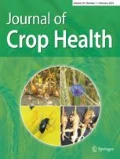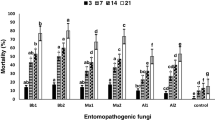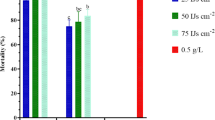Abstract
The current study was conducted to evaluate the efficacy of entomopathogenic fungi (EPF) as an alternative strategy for the sustainable control of Nilaparvata lugens. Three species of EPF, Beauveria bassiana, Metarhizium anisopliae and Lecanicillium lecanii, were tested against N. lugens with two suspensions of each tested EPF applied in different treatments. The observed mortality of N. lugens adults during the overall exposure period for the lowest and highest concentrations of each EPF ranged from 0–100%. At both highest and lowest concentrations of EPF, when sprayed on adult, the mortality of N. lugens was higher as compared to when sprayed on the stem pieces as food. A higher mortality rate was observed when the stem pieces were absent than when stem pieces were present. Maximum percent mortality of N. lugens was recorded due to the spray of highest concentration of M. anisopliae on only stem pieces (82.67%) and on adult N. lugens provided with stem pieces as food (93.33%) after 14 days of exposure interval. On the other hand, B. bassiana and L. lecanii were also responsible to cause more than 50% mortality of N. lugens in both treatments after 14 days of exposure interval. Results also indicated that maximum and minimum percent mycosis and sporulation from dead cadavers of N. lugens were recorded in both conidial suspensions of L. lecanii and M. anisopliae, respectively, in all treatments. The high efficacy levels recorded in the current study indicates that M. anisopliae can be effective biological control agents against N. lugens.
Zusammenfassung
Die aktuelle Studie wurde durchgeführt, um die Wirksamkeit entomopathogener Pilze (EPF) als alternative Strategie zur nachhaltigen Bekämpfung von Nilaparvata lugens zu bewerten. Drei EPF-Arten, Beauveria bassiana, Metarhizium anisopliae und Lecanicillium lecanii, wurden gegen N. Lugens getestet, wobei zwei Suspensionen von jedem getesteten EPF in verschiedenen Behandlungen angewendet wurden. Die beobachtete Mortalität von adulten N. lugens während des gesamten Expositionszeitraums für die niedrigste und höchste Konzentration jedes EPF lag zwischen 0 und 100 %. Sowohl bei der höchsten als auch bei der niedrigsten EPF-Konzentration war die Mortalität von N. lugens beim Sprühen auf Adulte höher als beim Sprühen auf Stängelteile als Nahrung. Die Mortalität war höher, wenn Stängelteile vorhanden waren als wenn keine Stängelteile vorhanden waren. Die maximale prozentuale Mortalität von N. lugens wurde nach 14-tägiger Exposition erreicht durch das Sprühen mit der höchsten Konzentration von M. anisopliae nur auf Stängelteile (82.67 %) und auf adulte N. lugens, die mit Stängelteilen als Nahrung (93.33 %) versorgt wurden. Andererseits waren B. bassiana und L. lecanii auch dafür verantwortlich, dass bei beiden Behandlungen nach 14 Tagen Exposition eine Mortalität von mehr als 50 % bei N. lugens auftrat. Die Ergebnisse zeigten auch, dass die maximale und minimale prozentuale Mykose und Sporulation von toten Körpern von N. lugens in beiden konidialen Suspensionen von L. Lecanii und M. anisopliae bei allen Behandlungen registriert wurden. Die in der aktuellen Studie festgestellte hohe Wirksamkeit weist darauf hin, dass M. anisopliae ein wirksames biologisches Bekämpfungsmittel gegen N. lugens sein kann.

Similar content being viewed by others
References
Ali S, Farooqi MA, Sajjad A, Ullah MI, Qureshi AK, Siddique B, Waheed W, Sarfraz M, Asghar A (2018) Compatibility of entomopathogenic fungi and botanical extracts against the wheat aphid, Sitobion avenae (Fab.) (Hemiptera: Aphididae). Egypt J Biol Pest Co 28:97
Ayala-Zermeño MA, Gallou A, Berlanga-Padilla AM, Serna-Domínguez MG, Arredondo-Bernal HC, Montesinos-Matías R (2015) Characterisation of entomopathogenic fungi used in the biological control programme of Diaphorina citri in Mexico. Biocontrol Sci Technol 25(10):1192–1207
Baehaki SE, Iswanto EH, Munawar D, Song Y‑H, Choi IR, Park H‑H (2017) Abilities of brown planthopper immigrant transmits rice ragged stunt virus on rice of some district of Java-Indonesia. Sch J Agric Vet Sci 4(8):300–310
Batta YA (2004) Control of the rice weevil (Sitophilus oryzae L., Coleoptera: Curculionidae) with various formulations of Metarhizium anisopliae. Crop Prot 23:103–108
Batta YA (2018) Efficacy of two species of entomopathogenic fungi against the stored-grain pest, Sitophilus granarius L. (Curculionidae: Coleoptera), via oral ingestion. Egypt J Biol Pest Co 28:44
Beris EI, Papachristos DP, Fytrou A, Antonatos SA, Kontodimas DC (2013) Pathogenicity of three entomopathogenic fungi on pupae and adults of the Mediterranean fruit fly, Ceratitis capitata (Diptera: Tephritidae). J Pest Sci 86:275–284
Chen CC, Ko VH, Chiu RJ (1978) Rice wilted stunt its transmission by the brown planthopper, Nilaparvata lugens (Stål). Plant Prot Bull Taiwan 20:374–376
Cherry AJ, Abalo P, Hell K (2005) A laboratory assessment of the potential of different strains of the entomopathogenic fungi Beauvaria bassiana (Balsamo) Vuillemin and Metarhizium anisopliae (Metschnikoff) to control Callosobruchus maculatus (F.) (Coleoptera: Bruchidae) in stored cowpea. J Stored Prod Res 41:295–309
Chomchan P, Miranda GJ, Shirako Y (2002) Detection of rice grassy stunt tenuivirus nonstructural proteins p2, p5 and p6 from infected rice plants and from viruliferous brown planthoppers. Arch Virol 147(12):2291–2300
Garraway MO, Evans RC (1984) Fungal nutrition and physiology. John Wiley & Sons, New York
Geng B‐W, Zhang R‐J (2004) Pathogenicity of Metarhizium anisopliae Var. Acridu to the deveolpmental stages of brown planthopper Nilaparvata lugens Stål and Sogatella furcifera (Horvath). Insect Sci 11(2):89–97
Gorman K, Liu Z, Denholm I, Bruggen KU, Nauen R (2008) Neonicotinoid resistance in rice brown planthopper, Nilaparvata lugens. Pest Manag Sci 64:1122–1125
Heinrichs EA, Medrano FG (1985) Influence of N fertilizer on the population development of brown planthopper (BPH). Int Rice Res Newsl 10:20–21
Heong KL, Hardy B (2009) Planthoppers: new threats to the Sustainability of intensive rice production systems in asia. International Rice Research Institute, Los Baños, pp 1–460
Hluchý M, Samšiňáková A (1989) Comparative study on the susceptibility of adult Sitophilus granarius (L.) (Coleoptera: Curculionidae) and larval Galleria mellonella (L.) (Lepidoptera: Pyralidae) to the entomogenous fungus Beauveria bassiana (Balsamo) Vuillemin. J Stored Prod Res 25:61–64
Horgan F (2009) Mechanisms of resistance: A major gap in understanding planthopper-rice interactions. In: Heong KL, Hardy B (eds) Planthoppers: New threats to the sustainability of intensive rice production systems in Asia. International Rice Research Institute, Los Baños, pp 281–302
Huang J, Qiao F, Zhang L, Rozelle S (2000) Farm pesticide, rice production and human health. Chinese Academy of Sciences, Beijing
Hywel-Jones NL, Gillespie AT (1990) Effect of temperature on spore germination in Metarhizium anisopliae and Beauveria bassiana. Mycol Res 94(3):389–392
Jandricic SE, Filotas M, Sanderson JP, Wraight SP (2014) Pathogenicity of conidia-based preparations of entomopathogenic fungi against the greenhouse pest aphids Myzus persicae, Aphis gossypii, and Aulacorthum solani (Hemiptera: Aphididae). J Invertebr Pathol 118:34–46
Jin S‐F, Feng M‐G, Chen J‐Q (2008) Selection of global Metarhizium isolates for the control of the rice pest Nilaparvata lugens (Homoptera: Delphacidae). Pest Manag Sci 64(10):1008–1014
Kassa A, Zimmermann G, Stephan D, Vidal S (2002) Susceptibility of Sitophilus zeamais Motschulsky (Coleoptera: Curculionidae) and Prostephanus truncatus (Horn) (Coleoptera: Bostrichidae) to entomopathogenic fungi from Ethiopia. Biocontrol Sci Technol 12:727–736
Kavallieratos NG, Athanassiou CG, Aountala MM, Kontodimas DC (2014) Evaluation of the entomopathogenic fungi Beauveria bassiana, Metarhizium anisopliae, and Isaria fumosorosea for control of Sitophilus oryzae. J Food Prot 77(1):87–93
Kirkland BH, Westwood GS, Keyhani NO (2004) Pathogenicity of Entomopathogenic Fungi Beauveria bassiana and Metarhizium anisopliae to Ixodidae tick species Dermacentor variabilis, Rhipicephalus sanguineus, and Ixodes scapularis. J Med Entomol 41(4):705–711
Kumar H, Maurya RP, Tiwari SN (2012) Studies on antibiosis mechanism of resistance in rice against brown planthopper, Nilaparvata lugens (Stal.). Ann Plant Prot Sci 28:98–101
Leao MP, Tiago PV, Andreote FD, de Araujo WL, de Oliveira NT (2015) Differential expression of the pr1A gene in Metarhizium anisopliae and Metarhizium acridum across different culture conditions and during pathogenesis. Genet Mol Biol 38:86–92
Li M, Lin H, Li S, Chen P, Jin L, Yang J (2012a) Virulence of entomopathogenic fungi to adults and eggs of Nilaparvata lugens Stal (Homopera: Delphacidae). Afr J Agric Res 7(14):2183–2190
Li MY, Li SG, Xu AM, Lin HF, Chen DX, Wang H (2014) Selection of Beauveria isolates pathogenic to adults of Nilaparvata lugens. J Insect Sci 14:32
Li MY, Lin HF, Li SG, Xu AM, Feng MF (2012b) Efficiency of entomopathogenic fungi in the control of eggs of the brown planthopper Nilaparvata lugens Stål (Homopera: Delphacidae). Afr J Microbiol Res 6(44):7162–7167
Liu JL, Yu JF, Wu JC, Yin JL (2008) Physiological responses to Nilaparvata lugens in susceptible and resistant rice varieties: Allocation of assimilates between shoots and roots. J Econ Entomol 101:384–390
Liu W, Xie Y, Xue J, Gao Y, Zhang Y, Zhang X, Tan J (2009) Histopathological changes of Ceroplastes japonicas infected by Lecanicillium lecanii. J Invertebr Pathol 101:96–105
Lovett B, Leger RJS (2015) Stress is the rule rather than the exception for Metarhizium. Curr Genet 61:253–261
Mannino MC, Huarte-Bonnet C, Davyt-Colo B, Pedrini N (2019) Is the insect cuticle the only entry gate for fungal infection? Insights into alternative modes of action of entomopathogenic fungi. J Fungi 5:33
Matsumura M, Takeuchi H, Satoh M, Sanasa-Morimura S, Otuka A, Watanabe T, Thanh DV (2009) Current status of insecticide resistance in rice planthoppers. In: Heong KL, Hardy B (eds) Planthoppers: New threats to the sustainability of intensive rice production systems in Asia. International Rice Research Institute, Los Baños, pp 233–244
Ment D, Gindin G, Rot A, Soroker V, Glazer I, Barel S, Samish M (2010) Novel technique for quantifying adhesion of Metarhizium anisopliae conidia to the tick cuticle. Appl Environ Microbiol 76:3521–3528
Mohan C, Sridhar RP, Nakkeeran S (2016) Studies on efficacy of entomopathogenic fungi Metarhizium anisopliae (Metchnikoff) Sorokin against Nilaparvata lugens (Stål). Int J Agric Sci Res 6(6):227–234
Moore D, Lord JC, Smith SM (2000) Pathogens. In: Subramanyam B, Hagstrum DW (eds) Alternatives to pesticides in stored-product IPM. Kluwer, Dordreecht, pp 193–227
Neves PMOJ, Hirose E, Tchujo PT, Moino AJR (2001) Compatibility of entomopathogenic fungi with neonicotinoid insecticides. Neotrop Entomol 30(2):263–268
Normile D (2008) Reinventing rice to feed the world. Science 321:330–333
Pedrini N (2018) Molecular interactions between entomopathogenic fungi (Hypocreales) and their insect host: Perspectives from stressful cuticle and hemolymph battlefields and the potential of dual RNA sequencing for future studies. Fungal Biol 122:538–545
Pu X‑Y, Feng M‑G, Shi C‑H (2005) Impact of three application methods on the field efficacy of a Beauveria bassiana-based mycoinsecticide against the false-eye leafhopper, Empoasca vitis (Homoptera: Cicadellidae) in the tea canopy. Crop Prot 24(2):167–175
Rafaluk-Mohr C, Wagner S, Joop G (2018) Cryptic changes in immune response and fitness in Tribolium castaneum as a consequence of coevolution with Beauveria bassiana. J Invertebr Pathol 152:1–7
Ramirez JL, Dunlap CA, Muturi EJ, Barletta ABF, Rooney AP (2018) Entomopathogenic fungal infection leads to temporospatial modulation of the mosquito immune system. PLoS Negl Trop Dis 12(4):e6433
Reddy AV, Devi RS, Dhurua S, Reddy DVV (2013) Study on the efficacy of some entomogenous fungi against brown plant hopper, Nilaparvata lugens Stal in irrigated rice. J Biopestic 6(2):139–143
Riasat T, Wakil W, Ashfaq M, Sahi ST (2011) Effect of Beauveria bassiana mixed with diatomaceous earth on mortality, mycosis and sporulation of Rhyzopertha dominica on stored wheat. Phytoparasitica 39:325–331
Rizwan M, Atta B, Rizwan M, Sabir AM, Shah ZU, Hussain M (2019b) Effect of the entomopathogenic fungus, Beauveria bassiana combined with diatomaceous earth on the red flour beetle, Tribolium castaneum (Herbst) (Tenebrionidae: Coleoptera). Egypt J Biol Pest Co 29:27
Rizwan M, Atta B, Sabir AM, Yaqub M, Qadir A (2019a) Evaluation of the entomopathogenic fungi as a non-traditional control of the Rice leaf roller, Cnaphalocrocis medinalis (Guenee) (Lepidoptera: Pyralidae) under controlled conditions. Egypt J Biol Pest Co 29:10
Rola AC, Pingali LP (1993) Pesticides, rice productivity, and farmers’ health: An economic assessment. International Rice Research Institute, Los Baños
Sabir AM, Shah ZU, Sabar M, Rizwan M, Atta B, Qadir A, Asghar M (2019) Rice Planthoppers: Potential threat to the sustainable rice production in the Punjab, Pakistan. In: 39th Pakistan Congress of Zoology, Department of Zoology, Islamia College University, Peshawar, Pakistan, p 229
Sanjaya Y, Ocampo VR, Caoili BL (2013) Infection process of entomopathogenic fungi Metarhizium anisopliae in the Tetrancyhus kanzawai (Kishida) (Tetranychidae: Acarina). Agrivita J Agric Sci 35(1):64–72
Sanjaya Y, Ocampo VR, Caoili BL (2015) Infection process of entomopathogenic fungi Beauveria bassiana in the Tetrancyhus kanzawai (Kishida) (Tetranychidae: Acarina). Arthropods 4(3):90–97
Saranya S, Ushakumari R, Jacob S, Philip BM (2010) Efficacy of different entomopathogenic fungi against cowpea aphid, Aphis craccivora (Koch). J Biopestic 3:138–142
Sarao PS (2015) Integrated Management of insect-pests of rice and basmati. Prog Farm 51:9–12
Scholte E‑J, Nghabi K, Kihonda J, Takken W, Paaijmans K, Abdulla S, Killeen GF, Knols BGJ (2005) An Entomopathogenic fungus for control of adult African malaria mosquitoes. Science 308(5728):1641–1642
Shaikh SH, Mohite P (2015) Effect of entomopathogenic fungi against brown plant hopper, Nilaparvata lugens (Stal.) (Hemiptera: Delphacidae) infesting rice. Int J Sci Res 4(10):905–907
Sokal RR, Rohlf FJ (1995) Biometry, 3rd edn. W. H. Freeman, New York
Song T‑T, Feng M‑G (2011) In vivo passages of heterologous Beauveria bassiana isolates improve conidial surface properties and pathogenicity to Nilaparvata lugens (Homoptera: Delphacidae). J Invertebr Pathol 106(2):211–216
Srivastava C, Chander S, Sinha SR, Palta RK (2009) Toxicity of various insecticides against Delhi and Palla population of brown planthopper (Nilaparvata lugens). Ind J Agric Sci 79:1003–1006
Sufyan M, Abbasi A, Wakil W, Gogi MD, Arshad M, Nawaz A, Shabbir Z (2019) Efficacy of Beauveria bassiana and Bacillus thuringiensis against maize stem borer Chilo Partellus (Swinhoe) (Lepidoptera: Pyralidae). Gesunde Pflanz. https://doi.org/10.1007/s10343-019-00465-7
Tefera T, Pringle KL (2003) Effect of exposure method to Beauveria bassiana and conodia concentration on mortality, mycosis, and sporulation in cadavers of Chilo partellus (Lepidoptera: Pyralidae). J Invertebr Pathol 84:90–95
Toledo AV, Alippi AM, de Remes Lenicov AMM (2011) Growth inhibition of Beauveria bassiana by bacteria isolated from the cuticular surface of the corn leafhopper, Dalbulus maidis and the planthopper, Delphacodes kuscheli, two important vectors of maize pathogens. J Insect Sci 11(1):29
Tounou A‑K, Agboka K, Poehling H‑M, Raupach K, Langewald J, Zimmermann G, Borgemeister C (2003) Evaluation of the entomopathogenic fungi Metarhizium anisopliae and Paecilomyces fumosoroseus (Deuteromycotina: Hyphomycetes) for control of the green leafhopper Empoasca decipiens (Homoptera: Cicadellidae) and potential side effects on the egg parasitoid Anagrus atomus (Hymenoptera: Mymaridae). Biocontrol Sci Technol 13(8):715–728
Vanitha K, Suresh S, Gunathilagaraj K (2011) Influence of brown planthopper Nilaparvata lugens (Stal.) feeding on nutritional biochemistry of rice plant. Oryza 48:142–146
Wang HY, Yang Y, Su JY, Shen JL, Gao CF, Chu YZ (2008) Assessment of the impact of insecticides on Anagrus nilaparvatae (Pang et Wang) (Hymenoptera: Mymanidae), an egg parasitoid of the rice planthopper, Nilaparvata lugens (Hemiptera: Delphacidae). Crop Prot 27(3–5):514–522
Wei G, Lai Y, Wang G, Chen H, Li F, Wang S (2017) Insect pathogenic fungus interacts with the gut microbiota to accelerate mosquito mortality. Proc Natl Acad Sci Usa 114:5994–5999
Wraight SP, Carruthers RI, Jaronski ST, Bradley CA, Garza CJ, Galaini-Wraight S (2000) Evaluation of the entomopathogenic fungi Beauveria bassiana and Paecilomyces fumosoroseus for microbial control of the silverleaf whitefly, Bemisia argentifolii. Biol Control 17:203–217
Yeo H, Pell JK, Alderson PG, Clark SJ, Pye BJ (2003) Laboratory evaluation of temperature effects on the germination and growth of entomopathogenic fungi and on their pathogenicity to two aphid species. Pest Manag Sci 59:156–165
Author information
Authors and Affiliations
Contributions
B. Atta, M. Rizwan and A.M. Sabir planned the research and designed the methodology; B. Atta conducted the experiments; B. Atta and M. Rizwan wrote the manuscript; M.D. Gogi and M.A. Farooq statistically analyzed the data; A.M. Sabir, M.D. Gogi, M.A. Farooq and Y.A. Batta reviewed the manuscript and gave suggestions and comments for its improvement. All the authors have read and approved the final manuscript.
Corresponding author
Ethics declarations
Conflict of interest
B. Atta, M. Rizwan, A.M. Sabir, M.D. Gogi, M.A. Farooq and Y.A. Batta declare that they have no competing interests.
Rights and permissions
About this article
Cite this article
Atta, B., Rizwan, M., Sabir, A.M. et al. Efficacy of Entomopathogenic Fungi Against Brown Planthopper Nilaparvata Lugens (Stål) (Homoptera: Delphacidae) Under Controlled Conditions. Gesunde Pflanzen 72, 101–112 (2020). https://doi.org/10.1007/s10343-019-00490-6
Received:
Accepted:
Published:
Issue Date:
DOI: https://doi.org/10.1007/s10343-019-00490-6
Keywords
- Rice stem
- Nilaparvata lugens
- Beauveria bassiana
- Metarhizium anisopliae
- Lecanicillium lecanii
- Biocontrol agents
- Virulence




